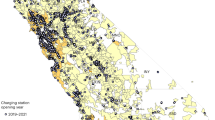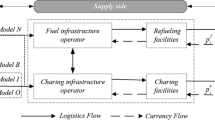Abstract
Electric vehicle charging points (EVCPs) are the foundation of the EV industry and are conducive to low-carbon transportation development. Research on EVCPs mainly focus on operation profits and layout, while no study assesses their economic premium. Aiming at providing a reference for the installation of EVCPs, this study employs a hedonic price model to evaluate the economic premium of CPs, based on apartment transactions and complex data on CPs in 2015 and 2016 in Beijing. The primary findings indicate the economic premium of CPs is significantly positive in both housing sale and rental markets. However, the impact of CPs on housing prices is heterogeneous in terms of complex floor area ratio and location. Specifically, the premium effect of CPs is more significant in larger complex and complex in the suburb. Following the above conclusions, we provide several policy pathways to promote the construction of CPs and their scientific location layout.


Similar content being viewed by others
Data availability
Not applicable.
Notes
Data source website: http://www.beijing.gov.cn/fuwu/lqfw/ztzl/xytxms/11/202006/t20200610_1921186.html.
The CP data from the Commission was no longer updated after 2017.
Beijing is a typical monocentric city. Although the scale of the city has been expanding in recent decades, the urban area within the 2nd ring road has historically been the central city, which is home to the majority of government offices, central business districts, and shopping plazas. Thus, the distance to the 2nd ring road can be viewed as the measure of distance to the downtown area.
References
Ahn K, Jang H, Song Y (2020) Economic impacts of being close to subway networks: a case study of Korean metropolitan areas. Res Transp Econ 83:100900
Bae CHC, Jun MJ, Park H (2003) The impact of Seoul’s subway Line 5 on residential property values. Transp Policy 10(2):85–94
Bajic V (1983) The effects of a new subway line on housing prices in metropolitan Toronto. Urban Stud 20(2):147–158
Ball MJ (1973) Recent empirical work on the determinants of relative house prices. Urban Stud 10(2):213–233
Blackman A, Qin P, Yang J (2020) How costly are driving restrictions? Contingent valuation evidence from Beijing. J Environ Econ Manag 104:102366
Bolt K, Ruta G, Sarraf M (2005) Estimating the cost of environmental degradation. In: Report of the Word Bank Environment Department. Chapter 6. Hedonic Prices Method, pp. E38–E50
Cervero R, Kang CD (2011) Bus rapid transit impacts on land uses and land values in Seoul, Korea. Transp Policy 18(1):102–116
Chen Z, Liu W, Yin Y (2017) Deployment of stationary and dynamic charging infrastructure for electric vehicles along traffic corridors. Transport Res Part C: Emerg Technol 77:185–206
Clark DE, Herrin WE (2000) The impact of public school attributes on home sale prices in California. Growth Chang 31(3):385–407
Currie J, Davis L, Greenstone M, Walker R (2015) Environmental health risks and housing values: evidence from 1,600 toxic plant openings and closings. Am Econ Rev 105(2):678–709
Dong J, Liu C, Lin Z (2014) Charging infrastructure planning for promoting battery electric vehicles: an activity-based approach using multiday travel data. Transport Res Part C: Emerg Technol 38:44–55
Dubin RA, Sung CH (1990) Specification of hedonic regressions: non-nested tests on measures of neighborhood quality. J Urban Econ 27(1):97–110
Follain JR, Jimenez E (1985) Estimating the demand for housing characteristics: a survey and critique. Reg Sci Urban Econ 15(1):77–107
Guo S, Zhao H (2015) Optimal site selection of electric vehicle charging station by using fuzzy TOPSIS based on sustainability perspective. Appl Energy 158:390–402
Hardman S, Jenn A, Tal G, Axsen J, Beard G, Daina N, Witkamp B (2018) A review of consumer preferences of and interactions with electric vehicle charging infrastructure. Transp Res Part D: Transp Environ 62:508–523
Hess DB, Almeida TM (2007) Impact of proximity to light rail rapid transit on station-area property values in Buffalo, New York. Urban Studies 44(5-6):1041–1068
IEA (2020) Global EV Outlook 2020. https://webstore.iea.org/global-ev-outlook-2020 (Accessed 15 June 2020)
Kiel KA, McClain KT (1995) House prices during siting decision stages: The case of an incinerator from rumor through operation. J Environ Econ Manag 28(2):241–255
Kihm A, Trommer S (2014) The new car market for electric vehicles and the potential for fuel substitution. Energy Policy 73:147–157
Lancaster KJ (1966) A new approach to consumer theory. J Polit Econ 74(2):132–157
Li B, Jin C, Jansen SJ, van der Heijden H, Boelhouwer P (2021) Residential satisfaction of private tenants in China’s superstar cities: the case of Shenzhen, China. Cities 118:103355
Li X, Yu B (2019) Peaking CO2 emissions for China’s urban passenger transport sector. Energy Policy 133:110913
Liang J, Qiu Y, Liu P, He P (2022) Benefits of sustainable transportation infrastructure: evidence from the housing market response to electric vehicle charging stations in California. Pengfei and He, Pan, Benefits of sustainable transportation infrastructure: evidence from the housing market response to electric vehicle charging stations in California (February 28, 2022)
Linneman P (1980) Some empirical results on the nature of the hedonic price function for the urban housing market. J Urban Econ 8(1):47–68
Ma SC, Fan Y (2020) A deployment model of EV charging piles and its impact on EV promotion. Energy Policy 146:111777
Mak HY, Rong Y, Shen ZJM (2013) Infrastructure planning for electric vehicles with battery swapping. Manag Sci 59(7):1557–1575
Mei Y, Gao L, Zhang J, Wang J (2020) Valuing urban air quality: a hedonic price analysis in Beijing, China. Environ Sci Pollut Res 27(2):1373–1385
Mei Y, Sohngen B, Babb T (2018a) Valuing urban wetland quality with hedonic price model. Ecol Indic 84:535–545
Mei Y, Zhao X, Lin L, Gao L (2018b) Capitalization of urban green vegetation in a housing market with poor environmental quality: evidence from Beijing. J Urban Plann Dev 144(3):05018011
Mei Y, Gao L, Zhang W, Yang FA (2021) Do homeowners benefit when coal-fired power plants switch to natural gas? Evidence from Beijing, China. J Environ Econ Manag 110:102566
Mi Z, Sun X (2021) Provinces with transitions in industrial structure and energy mix performed best in climate change mitigation in China. Commun Earth Environ 2(1):1–12
Morrissey P, Weldon P, O’Mahony M (2016) Future standard and fast charging infrastructure planning: an analysis of electric vehicle charging behaviour. Energy Policy 89:257–270
Mulley C (2014) Accessibility and residential land value uplift: identifying spatial variations in the accessibility impacts of a bus transitway. Urban Stud 51(8):1707–1724
Peterson SB, Michalek JJ (2013) Cost-effectiveness of plug-in hybrid electric vehicle battery capacity and charging infrastructure investment for reducing US gasoline consumption. Energy Policy 52:429–438
Rosen S (1974) Hedonic prices and implicit markets: product differentiation in pure competition. J Polit Econ 82(1):34–55
Sadeghi-Barzani P, Rajabi-Ghahnavieh A, Kazemi-Karegar H (2014) Optimal fast charging station placing and sizing. Appl Energy 125:289–299
San Román TG, Momber I, Abbad MR, Miralles AS (2011) Regulatory framework and business models for charging plug-in electric vehicles: infrastructure, agents, and commercial relationships. Energy Policy 39(10):6360–6375
Schroeder A, Traber T (2012) The economics of fast charging infrastructure for electric vehicles. Energy Policy 43:136–144
Shojaabadi S, Abapour S, Abapour M, Nahavandi A (2016) Simultaneous planning of plug-in hybrid electric vehicle charging stations and wind power generation in distribution networks considering uncertainties. Renew Energy 99:237–252
Thaler R (1978) A note on the value of crime control: evidence from the property market. J Urban Econ 5(1):137–145
Tian C, Peng Y, Wen H, Yue W, Fang L (2020) Subway boosts housing values, for whom: a quasi-experimental analysis. Res Transport Econ, 100844
Voith R (1991) Transportation, sorting and house values. Real Estate Econ 19(2):117–137
Yang J, Liu AA, Qin P, Linn J (2020a) The effect of vehicle ownership restrictions on travel behavior: evidence from the Beijing license plate lottery. J Environ Econ Manag 99:102269
Yang M, Zhang L, Dong W (2020b) Economic benefit analysis of charging models based on differential electric vehicle charging infrastructure subsidy policy in China. Sustain Cities Soc 59:102206
Yu JL, Jia Q, Hu HQ (2021) Charging infrastructure construction from the perspective of new infrastructure. Energy Rep 7:224–229
Zakaria F, Fatine FA (2021) Towards the hedonic modelling and determinants of real estates price in Morocco. Soc Sci Human Open 4(1):100176
Zhang B, Niu N, Li H, Wang Z, He W (2021) Could fast battery charging effectively mitigate range anxiety in electric vehicle usage? Evidence from large-scale data on travel and charging in Beijing. Transp Res Part D: Transp Environ 95:102840
Zhao HR, Guo S, Fu LW (2014) Review on the costs and benefits of renewable energy power subsidy in China. Renew Sust Energ Rev 37:538–549
Zhao Z, Zhang L, Yang M, Chai J, Li S (2020) Pricing for private charging pile sharing considering EV consumers based on non-cooperative game model. J Clean Prod 254:120039
Zhao C, Wang K, Dong X, Dong K (2022) Is smart transportation associated with reduced carbon emissions?. The case of China. Energy Econ 105:105715
Zheng Y, Dong ZY, Xu Y, Meng K, Zhao JH, Qiu J (2014) Electric vehicle battery charging/swap stations in distribution systems: comparison study and optimal planning. IEEE Trans Power Syst 29(1):221–229
Zhu L, Wang P (2019) Study on indirect network effects on the construction of electric vehicle charging piles based on game theory analysis. Energy Procedia 158:3853–3858
Funding
This work was supported by the National Natural Science Foundation of China (Grant numbers 71803192 and 71703166).
Author information
Authors and Affiliations
Contributions
All authors contributed to the study conception and design. Material preparation, data collection, and analysis were performed by CZ. The first draft of the manuscript was written by LG and YM, and all authors commented on previous versions of the manuscript. All authors read and approved the final manuscript.
Corresponding author
Ethics declarations
Ethics approval and consent to participate
Not applicable.
Competing interests
The authors declare no competing interests.
Additional information
Responsible Editor: Philippe Garrigues
Publisher’s note
Springer Nature remains neutral with regard to jurisdictional claims in published maps and institutional affiliations.
Rights and permissions
About this article
Cite this article
Gao, L., Zhao, C. & Mei, Y. Assessing the economic premium of electric vehicle charging points: a hedonic price analysis in Beijing, China. Environ Sci Pollut Res 29, 84546–84561 (2022). https://doi.org/10.1007/s11356-022-21735-4
Received:
Accepted:
Published:
Issue Date:
DOI: https://doi.org/10.1007/s11356-022-21735-4




